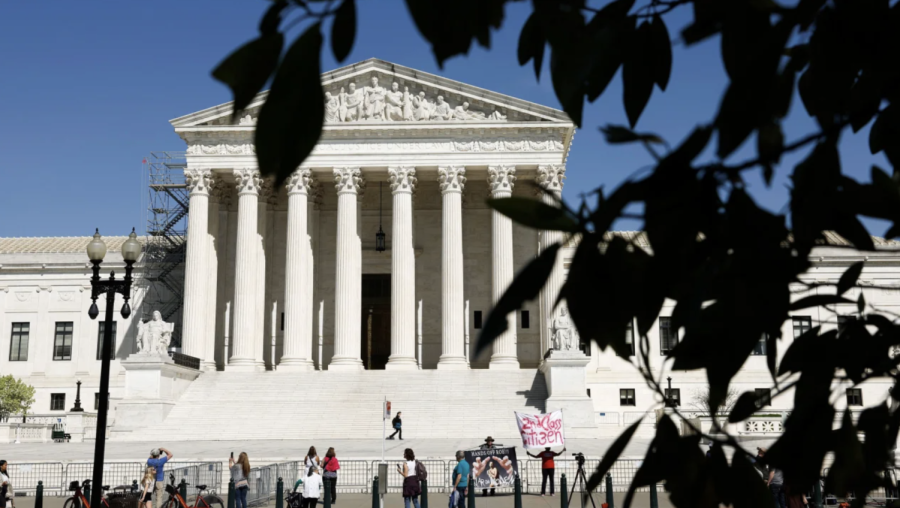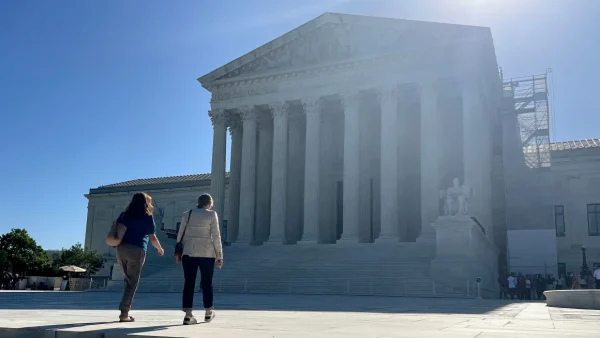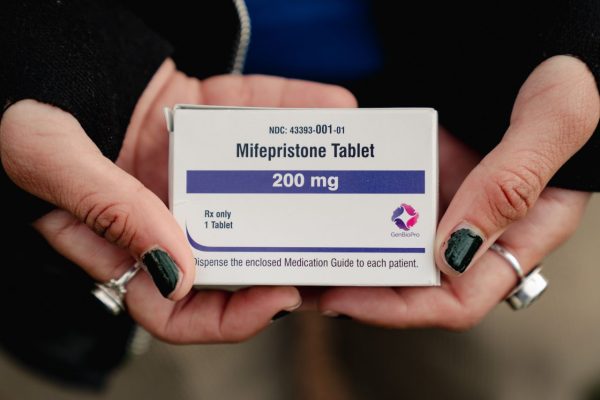Supreme Court faces Friday deadline in case that could shape abortion access and the future of American health care
People visit the front of the Supreme Court Building on April 19, 2023, in Washington, DC. Anna Moneymaker/Getty Images
April 21, 2023
CNN– A deadline looms at midnight Friday for the most critical abortion case before the Supreme Court since its decision to overturn Roe v. Wade last summer.
The future of a widely used medication drug to end pregnancies is the specific issue before the court. But nothing less than the health care options of American women and even the viability of US regulatory approvals for routine drugs are in question.
Justice Samuel Alito earlier this week granted the high court more time to consider a ruling by a Texas judge that would block approval of mifepristone and to extend a temporary hold on a subsequent appeals court ruling, which would let the government’s approval of the drug stand but agreed access could be limited.
The extension for the Supreme Court’s impending order is until 11:59 p.m. ET Friday, and until then, the drug remains available.
But the precarious waiting period has been a study in microcosm of the deep uncertainty about the continued availability of abortion in some states nearly a year after the court’s conservative majority overturned the constitutional right to the procedure. It reflects the way that the post-Roe anti-abortion movement has escalated its effort to eradicate abortion rights everywhere. The current case also shows that President Joe Biden’s administration is ready to intervene aggressively in the courts to try to protect abortion rights.
The fallout from the Texas ruling, which blocked Food and Drug Administration approval of the drug, is also thrusting abortion back into the Washington political storm in a way that has been a liability for the Republican Party with more moderate and swing voters – an ironic consequence of conservatives’ decadeslong campaign against Roe.
There’s another irony to this all-consuming legal collision. Alito wrote in his majority opinion overturning Roe last summer that the 1973 decision was wrong because justices had usurped the Constitution and taken away from lawmakers the duty of deciding matters related to abortion rights. But the power play by the Trump-appointed Texas judge in this case, which swiftly rose to the high court, shows that Alito and his colleagues are going to be embroiled in deciding abortion law for years to come.
As with most things about the Supreme Court, the reasoning behind Alito’s extension of the temporary hold was unclear to outsiders. He could simply have been providing his colleagues more time to consider an extraordinarily complex legal and clinical issue. Or it may be that there is no current majority on the bench for any course of action. The court is considering both the ruling by District Judge Matthew Kacsmaryk to halt the approval of mifepristone and a 5th US Circuit Court of Appeals decision that allowed the FDA’s certification of the drug to stand but limited its use.
The Supreme Court might uphold either ruling, reject them, cobble together a middle path or extend the stay on Kacsmaryk’s ruling pending litigation in what could be a fateful case. There is also an order contradictory to Kacsmaryk’s, from a judge in Washington state, requiring the FDA to keep mifepristone available in 18 liberal jurisdictions, which is further adding to the legal imbroglio.
Former federal prosecutor Jennifer Rodgers said on “CNN News Central” on Wednesday that the fact that the court didn’t order a longer stay than the current two days could mean justices “are seriously thinking about affirming some of what the Fifth Circuit said.”
“If they agree with the Fifth Circuit as to which parts of Judge Kacsmaryk’s (order) could survive or could be rejected, it would mean that women would have to go in person, multiple times, to their doctor and could only get mifepristone up to seven weeks (into a pregnancy),” Rodgers said.
Why the current case is so important
The decisions that the justices could make will have wide-ranging implications beyond the simple question of if and when mifepristone can be used.
— The Supreme Court could potentially deliver a ruling that would effectively allow a single judge – in this case, in a red corner of Texas – to influence the medical choices and restrict the freedoms of millions of American women, not just in states where abortion is banned but also in more liberal areas where it is legal.
“This was an unelected judge making a decision – a federal decision basically on this,” GOP Rep. Nancy Mace of South Carolina told CNN’s Manu Raju on Wednesday.
This sweeping use of judicial power not only appears to offend the spirit of the Supreme Court ruling last year on allowing legislators to decide abortion rights. The ruling by Kacsmaryk, a long-time opponent of abortion rights, exemplifies the ambition of parts of the anti-abortion rights movement in the post-Roe era.
But it could also open the way for liberal judges to use their power in the same way, and create a thicket of litigation that could also end up at the Supreme Court. The judiciary’s nominal reputation for restraint and staying out of partisan politics is already being threatened.
— The Supreme Court’s eventual ruling could also have a sweeping impact on how mifepristone is prescribed – often as part of a two-drug regimen to end pregnancies and after miscarriages – and, in some cases, on the availability of abortion services to millions of women. As with the aftermath of the repeal of Roe v. Wade, the justices’ ruling here could mean that women’s rights and freedoms to make their own health care decisions could be more curtailed in some states than others.
Katie Watson, an associate professor at Northwestern University, told CNN’s Jake Tapper on Wednesday that even a partial loss of access could have grave consequences. “Approximately a half million women used this drug in recent years and they depend on it,” she said.
— Critics argue that if Kacsmaryk’s ruling is upheld – along with the Fifth Circuit’s limitations on the use of mifepristone – it would validate a decision of a single judge or panel with no medical expertise over standards of science and clinical analysis. Mifepristone has been safely prescribed since the FDA approved it two decades ago. But anti-abortion doctors and medical associations argued in the case that the agency violated the law in how it approved the drug for abortions in 2000. By filing their suit in Amarillo, Texas, they guaranteed that Kacsmaryk would hear the case.
“They basically have said, these two judges, hey we know better than the FDA,” Minnesota Democratic Sen. Amy Klobuchar told Tapper.
Such a precedent could create chaos in the pharmaceutical industry and in medicine and threaten the regulatory system for clearing new treatments. It might also prompt other judges to take aim at approved drugs – for instance, birth control pills or even treatments for common ailments and pain killers. Such a scenario would directly undermine the entire premise of federal government.
“The impact, even if they say the Washington order can stand and the Texas order can stand, is that the FDA cannot regulate federally. … The impact is enormous,” Watson said.
— The justices’ deliberations may also have a profound effect on the reputation of the court. Many moderate Americans increasingly see the conservative majority as a group of unelected right-wingers flouting public opinion on issues like abortion, which majorities do not want to be banned outright, according to many polls. While the conservative justices insist that they are simply interpreting the Constitution as written and returning issues to the states, a decision that causes massive upheaval could harm the court’s image at a time when it is also reeling from ethics questions surrounding conservative Justice Clarence Thomas.
— A decision to ban mifepristone could cause shockwaves like those set off by the overturning of Roe, which hurt Republicans in last year’s midterm elections and most recently galvanized voters in support of a liberal candidate in Wisconsin’s Supreme Court race earlier this month. Advocates who believe abortion is immoral may not care about partisan implications. The repeal of a constitutional right to an abortion validated a half-century-long campaign by the anti-abortion movement in one of the most significant political victories in modern American history. But the Republican Party risks paying a price in next year’s presidential and congressional elections. Liberals might have been complacent in a belief that Roe would never be overturned, but they have effectively leveraged the issue ever since.
“Our Republican colleagues, for the most part, have been silent on this,” said Klobuchar, referring to the cases currently being considered by the Supreme Court. “We are standing up, the Democratic Party, President Biden, for women’s rights, to say women have a right to make their own health care decisions.”
Mace, the South Carolina Republican from a competitive district, delivered a warning on Wednesday that the GOP’s position could cost it the House majority in 2024.
“It’s a purple district, and as a bellwether for the rest of the country, it’s one of the reasons why we will not win the popular vote in ’24 if we continue down this path of extremism,” Mace said of her Charleston-area seat. “That is not where the American people are, and we need to have a conversation, where are we and where is the middle ground?”
How the abortion debate is changing America
The Supreme Court’s deliberations come as abortion is already at the center of federal, local and state government policy debates and is stretching the court system with dueling rulings that are further politicizing the legal system.
In the six months after the Supreme Court overturned Roe, there were about 32,000 fewer abortions than expected in the US, according to a new study by the Society of Family Planning. And CNN reported Wednesday that fewer medical students are applying to ob/gyn residency programs, with the decline most marked in states with the strongest restrictions.
And a patchwork of laws related to abortion, and its restricted access, is emerging across the country. On Wednesday, for instance, Mississippi Republican Gov. Tate Reeves signed new bills that he said will enshrine a “culture of life” by widening a safety net for foster children and expanding adoptions and resources for women who discover they are pregnant.
Last week, Florida Republican Gov. Ron DeSantis signed a bill outlawing most abortions in the state after six weeks – a point by which many women do not know they are pregnant. The potential presidential candidate’s reluctance to publicize his move, which was announced late at night, reflected the tug of war in the GOP between the desire to go all in on banning abortion and a recognition that doing so could alienate more moderate voters in a national election.


























